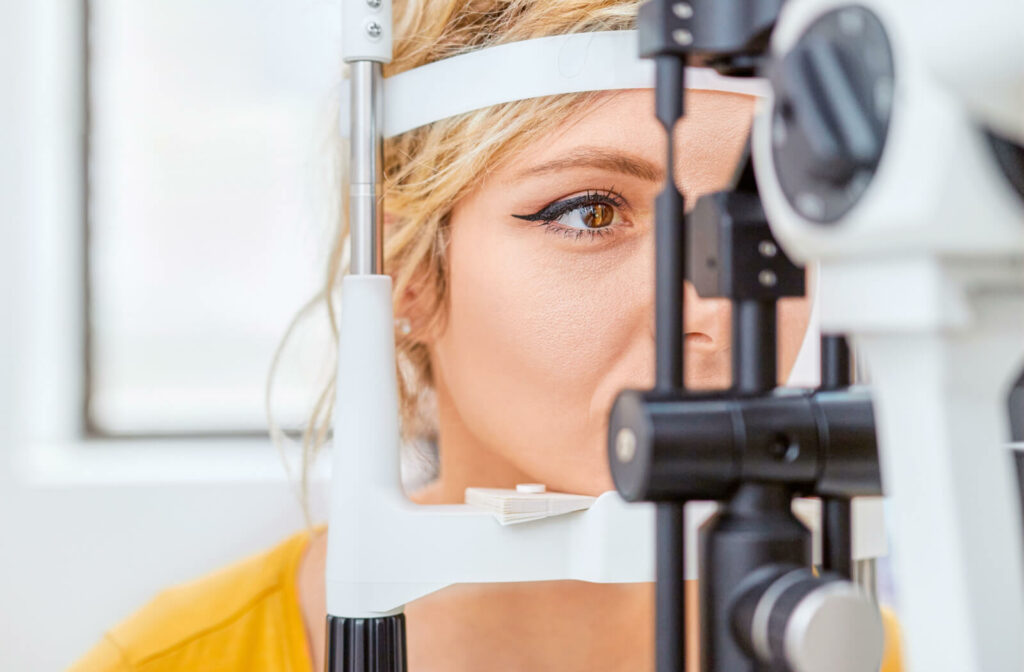Glaucoma, dubbed the ‘silent thief of sight,’ is a group of eye diseases that damage the optic nerve, resulting in irreversible vision loss. One of the challenges of glaucoma is that it often develops without noticeable symptoms until the disease has advanced.
However, adult and senior eye exams can help detect vision changes in glaucoma, such as loss of peripheral (side) vision, blurry vision, and eye pain. Prompt treatment can help slow down the progression of the disease and prevent further vision loss.
How Does Glaucoma Develop?
Glaucoma often occurs due to increased intraocular pressure (IOP), which damages the optic nerve at the back of the eye. However, you can have normal eye pressure and still get glaucoma.
The optic nerve transmits visual information from the eye to the brain. Aqueous fluid is a clear fluid your eye makes, this fluid also leaves the eye through channels. But when these channels are blocked or partially obstructed, it can lead to increased eye or intraocular pressure, which damages the optic nerve, causing vision loss.
Other causes of high pressure may include:
- Dilating eye drops
- Medications, such as corticosteroids
- Poor or reduced blood flow to your optic nerve
- High blood pressure
Types of Glaucoma and Its Symptoms
There are several types of glaucoma. The two primary types of glaucoma are open-angle glaucoma and angle-closure glaucoma. Symptoms of glaucoma can vary depending on the type and severity of the condition.
Open-Angle Glaucoma
Open-angle or chronic glaucoma is the most common form and progresses gradually without pain. There are no signs or symptoms except gradual vision loss, which many people don’t notice in the early stages.
Angle-Closure Glaucoma
Also called acute angle-closure, angle-closure glaucoma is characterized by sudden, severe symptoms, such as pain and rapid vision loss, within a day of it developing, making it an eye emergency. You should call your eye doctor immediately if you have severe pain, nausea, and blurred vision to prevent permanent damage.
Congenital Glaucoma
This type of glaucoma occurs in babies born with a defect that prevents fluid drainage. Symptoms can include cloudy eyes, excessive tearing, or light sensitivity.
Normal-Tension Glaucoma
In normal-tension glaucoma, there is damage to the optic nerve with no increase in eye pressure. The cause of damage to the optic nerve isn’t known, but extreme sensitivity or a lack of blood flow to your optic nerve may play a role.
Secondary Glaucoma
This type of glaucoma occurs as a side effect of other eye conditions, an injury, or medicines, such as corticosteroids.
Risk Factors for Developing Glaucoma
Glaucoma is the second leading cause of blindness in the world. While family history can increase your risk of developing glaucoma, there are other factors, including:
- Age
- Ethnicity
- Eye problems
- Medical history
- Use of certain medications
Subtle Changes in Vision
There are often no noticeable signs or symptoms in the early stages of glaucoma. These are usually subtle and often only noticed when vision loss progresses and depending on the type of glaucoma.
Open-Angle Glaucoma
- No symptoms in the early stages
- Gradual black spots develop in your side vision
- In later stages, there’s progression to central vision loss
Angle-Closure Glaucoma
- Severe headache
- Severe eye pain
- Nausea or vomiting
- Blurry vision
- Halos around lights
- Eye redness
Normal-Tension Glaucoma
- No symptoms in the early stages
- Gradual blurry vision
- Loss of side vision in later stages
Glaucoma in Children
- Cloudy eyes
- Increased blinking
- Tearing
- Blurred vision
- Nearsightedness
- Headache
How to Diagnose Glaucoma
Diagnosing glaucoma involves a comprehensive eye examination performed by an optometrist or ophthalmologist. Common steps and tests involved in the diagnostic process can include the following:
- A detailed look at your family history
- A dilated eye exam to check the optic nerve
- A tonometry test to measure eye pressure
- A pachymetry test to measure the thickness of the cornea
- A visual field test to check peripheral vision
How to Prevent Vision Loss
You can’t prevent glaucoma. While glaucoma seldom has noticeable early warning signs, when you take the following measures, you can help slow its progression and prevent vision loss:
- Know your family’s eye health history and your risk factors
- Wear protection to prevent eye injuries
- Take prescribed eye medication regularly
- Get regular eye exams, regardless of noticeable vision problems
Prioritize Healthy Eyes and Vision
Recognizing the gradual signs of glaucoma is crucial in preventing irreversible vision loss. Subtle changes in vision, such as peripheral vision loss and the perception of halos, should not be ignored.
Regular eye exams, especially for those with a family history of glaucoma or belonging to high-risk groups, are essential for early detection and intervention. By staying vigilant, being proactive about your eye health, and seeking timely medical attention, you can protect your vision for longer. Book an eye exam with Dr. Jennifer L. Shane & Associates to help detect changes to your vision.



